How did the development of the atomic bomb change the world?
All of my information regarding the Manhattan Project before this unit came from the TRAILER of the Oppenheimer movie. I knew the US built a different type of bomb and that it had devastating effects that ended WWII. I didn’t even know enough to have an opinion on the driving question.
We started the project with lectures about the people, science, and effect of the atomic bomb. We then wrote a piece on any event or person that we wanted talk about and argue why it was historically significant. My choice was to write about Pearl Harbour which led me to research and gave me a chance to revisit the idea of historical significance which we would be using throughout this project. You can see my argument for why Pearl Harbour is historically significant here.

Next, instead of keystones or milestones like most humanities projects, we dived into the creation of the final product by being put into groups of 6. Our goal over the next few weeks was to research, write, design, and publish an interactive book on the historical significance of the Manhattan Project. Our group took a loooong time to brainstorm ideas for our book but in the end we came up with an original and creative idea for our book that no other group did. Instead of writing the book from an outside point of view, we wrote the book from Oppenheimer’s perspective, and turned it into his journal.
 For part of this project, two group members went on a field school to New Mexico, and visited the Trinity site and a museum which is where they interviewed people and took photos for our book. Back at Seycove, the rest of us split up the book into sections. As the project manager, I helped split up the tasks and research topics to start the process of creating out book. I personally set goals for each class and made sure everyone knew what their job was when they left class each day. I was in charge of finding and writing the information for the “classified file” and the opening writing about Oppenheimer becoming director of Los Alamos.
For part of this project, two group members went on a field school to New Mexico, and visited the Trinity site and a museum which is where they interviewed people and took photos for our book. Back at Seycove, the rest of us split up the book into sections. As the project manager, I helped split up the tasks and research topics to start the process of creating out book. I personally set goals for each class and made sure everyone knew what their job was when they left class each day. I was in charge of finding and writing the information for the “classified file” and the opening writing about Oppenheimer becoming director of Los Alamos.
One of the requirements of our book was making sure each team member was in a video so my group came up with the idea to do a reenactment of Vice President Truman becoming President and then finding out about the Manhattan Project. This emphasized how much of a secret the building of the atomic bomb was even at high levels of government.

Overall my group worked really well together. Everybody did their part and helped to come up with ideas when our book got off track or when our thesis needed to be revised. I really liked collaborating in this project and I think it would have been difficult to do on my own. We could build our ideas off of each other and research and develop the part of the book we were interested in doing. I also liked how we each had roles as it made things go smoother. We knew who would edit the videos, for example, and who to ask for help when designing the layout of our pages. We could rely on each other to do our part while still being able to ask for help and get a response when we needed one.

 Much of this project was about communication and research skills. As a group we found it really challenging to find sources that talked about Oppenheimer’s thoughts, which caused difficulty considering it was supposed to be from his perspective. This led to deeper research and creativity. I really love how we had different ways to show our information. We had the classified file at the beginning, newspaper to show the historical significance the end, as well as interviews, a video, and photos. To make our book to feel more like a journal we called the chapters “entries,” crossed out words, and coffee stains on the pages.
Much of this project was about communication and research skills. As a group we found it really challenging to find sources that talked about Oppenheimer’s thoughts, which caused difficulty considering it was supposed to be from his perspective. This led to deeper research and creativity. I really love how we had different ways to show our information. We had the classified file at the beginning, newspaper to show the historical significance the end, as well as interviews, a video, and photos. To make our book to feel more like a journal we called the chapters “entries,” crossed out words, and coffee stains on the pages.
Now at the end of the project, I realize how much more to the Manhattan project there is than I thought. It was interesting to learn “little’ details like the government actually built a full town so the scientists could bring their families. It was also interesting to learn more about why the decision to build, and drop the bomb is controversial. Below you can see my group’s final product. Make sure you check out the top-notch reenactment video as well as read why this event is so historically significant.
 In my writing journal you will also find my
In my writing journal you will also find my 


 This brings us to my favourite part of this project the stock simulator. The point of the stock simulator was to deepen our understanding of investing and understanding how it could fit into the real world.
This brings us to my favourite part of this project the stock simulator. The point of the stock simulator was to deepen our understanding of investing and understanding how it could fit into the real world.

 I liked how my podcast business card turned out. I did multiple drafts and got feedback from a lot of people and in the end, liked the look of what I created. I was also impressed by how well my class got our room ready for the exhibition. We had a lot of problems at the beginning like how we didn’t have any tables and all of our plans needed tables but as a class, we figured it out and created an impressive office.
I liked how my podcast business card turned out. I did multiple drafts and got feedback from a lot of people and in the end, liked the look of what I created. I was also impressed by how well my class got our room ready for the exhibition. We had a lot of problems at the beginning like how we didn’t have any tables and all of our plans needed tables but as a class, we figured it out and created an impressive office.

















 I really liked mine.. Thinking about what makes me Faith Scheewe made me think about where I lived, what I do, and who is in my life. I found that it was fun to write and a good start to this project. We used a website to collaborate on what we already know about Indigenous people and issues that are relevant to them for this project and what we still need to know. While doing this I realized how much general information I had but not very many specific information.
I really liked mine.. Thinking about what makes me Faith Scheewe made me think about where I lived, what I do, and who is in my life. I found that it was fun to write and a good start to this project. We used a website to collaborate on what we already know about Indigenous people and issues that are relevant to them for this project and what we still need to know. While doing this I realized how much general information I had but not very many specific information. This brings us to when we started reading our class novel Marrow Thieves, by Cherie Dimaline. While it was set in the future, it reflected on issues shown presently and in the past. For example it referred to residential schools as part of the past and also as something happening again in the book. While reading the book, I would analyze what I was reading and make connections to issues being brought up today. For example we listened to a podcast on the Indian Act and read articles on topics like cultural appropriation and indigenous resurgence. Every couple of chapters we did a reflection. We called this a contribution as we needed to bring those thoughts to class. Sharing those contributions helped to see other peoples points of view. I did a poem, an image, list of questions and drawings. In the end, after we finished the book, we did a quick write reflection for 15 minutes about the connections we saw from the book to the past and to right now.
This brings us to when we started reading our class novel Marrow Thieves, by Cherie Dimaline. While it was set in the future, it reflected on issues shown presently and in the past. For example it referred to residential schools as part of the past and also as something happening again in the book. While reading the book, I would analyze what I was reading and make connections to issues being brought up today. For example we listened to a podcast on the Indian Act and read articles on topics like cultural appropriation and indigenous resurgence. Every couple of chapters we did a reflection. We called this a contribution as we needed to bring those thoughts to class. Sharing those contributions helped to see other peoples points of view. I did a poem, an image, list of questions and drawings. In the end, after we finished the book, we did a quick write reflection for 15 minutes about the connections we saw from the book to the past and to right now.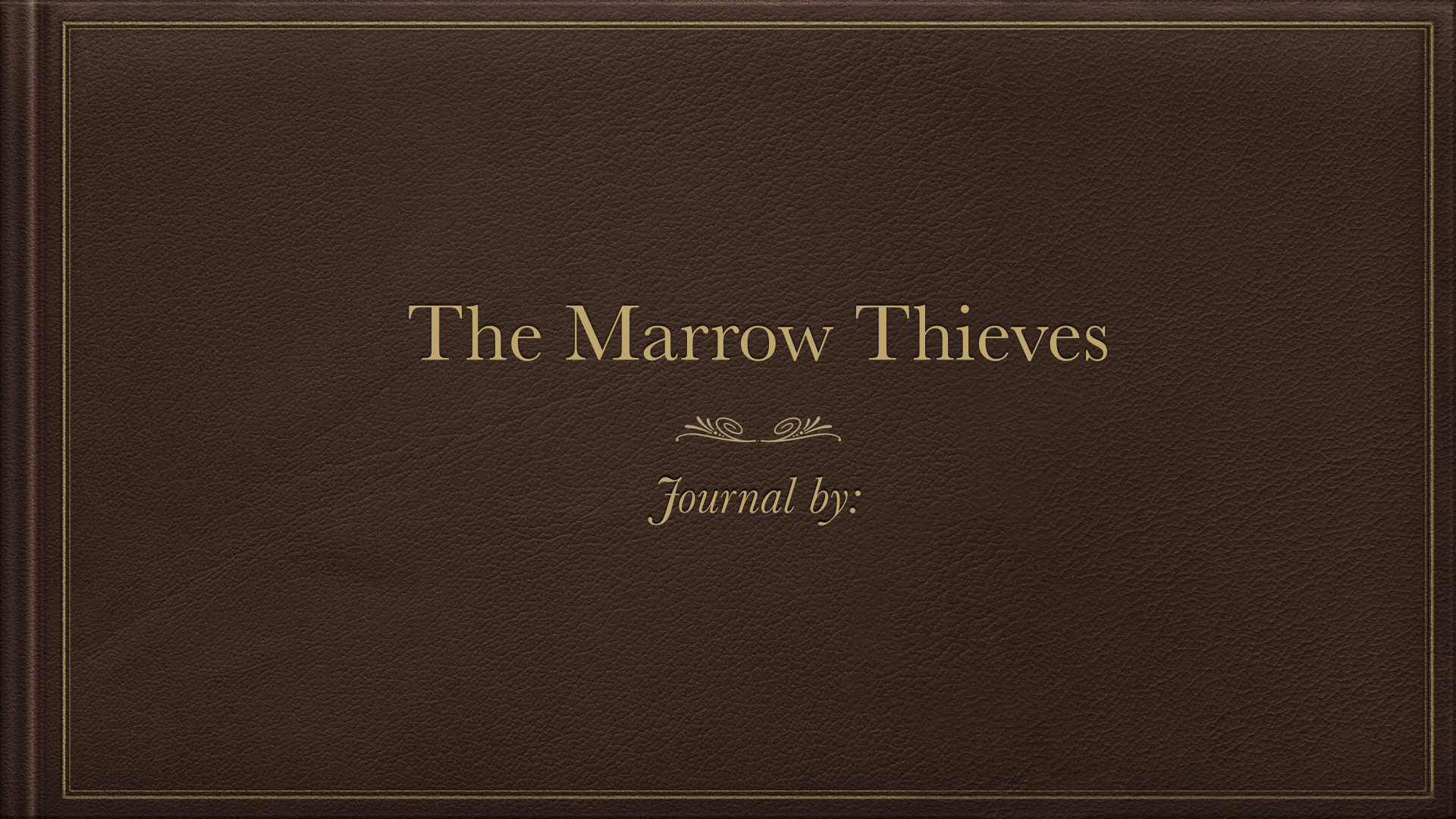



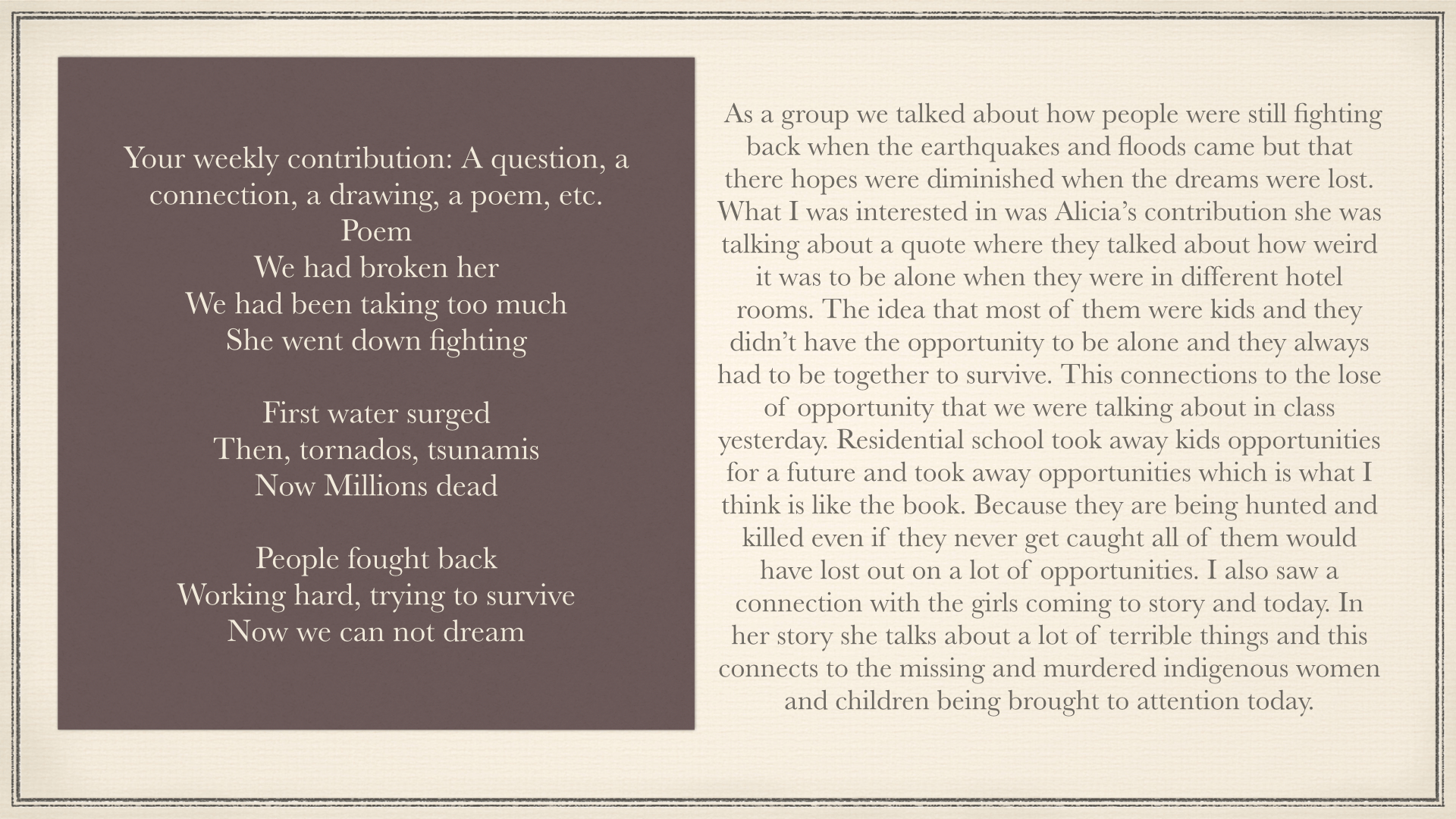


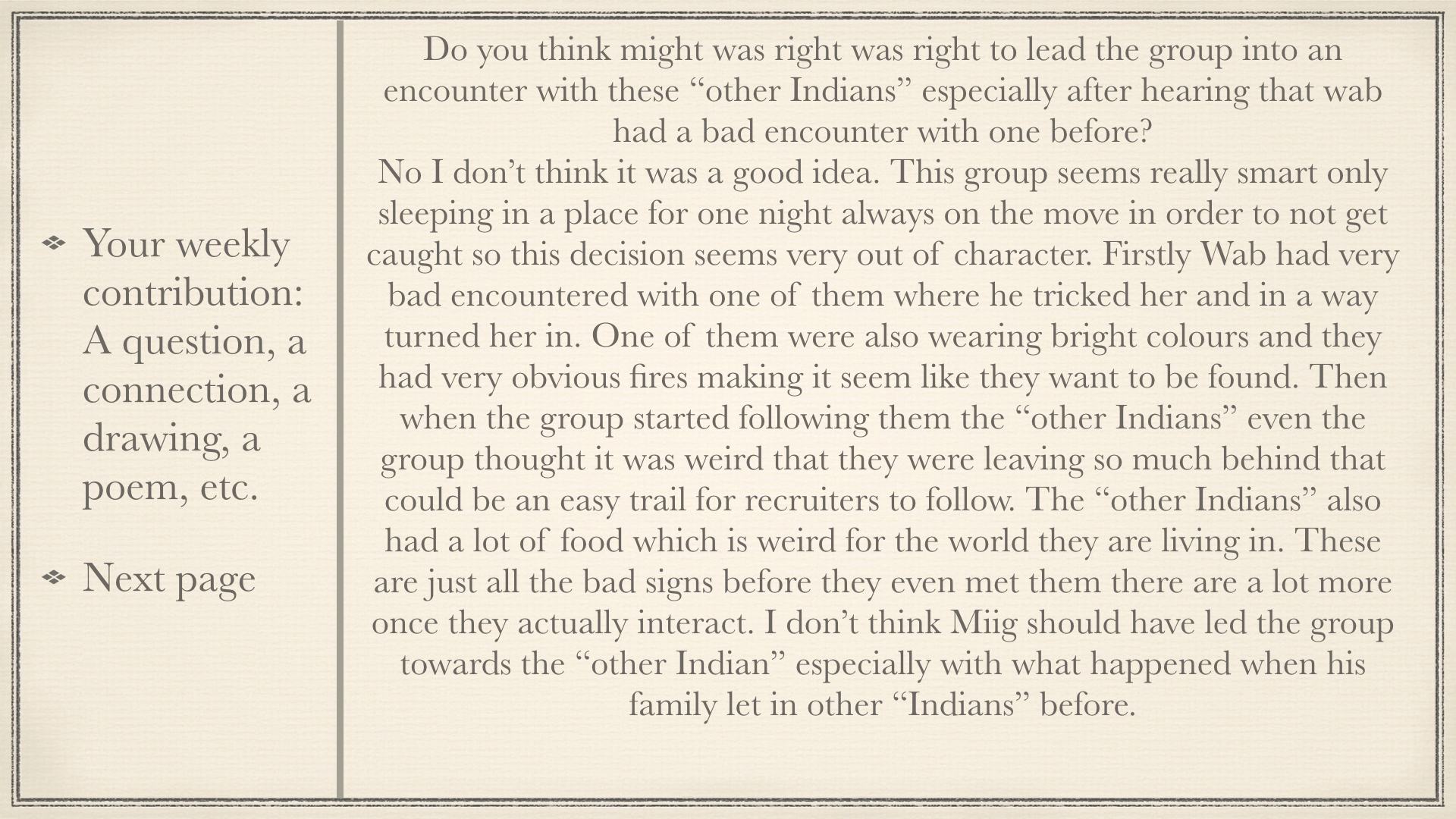


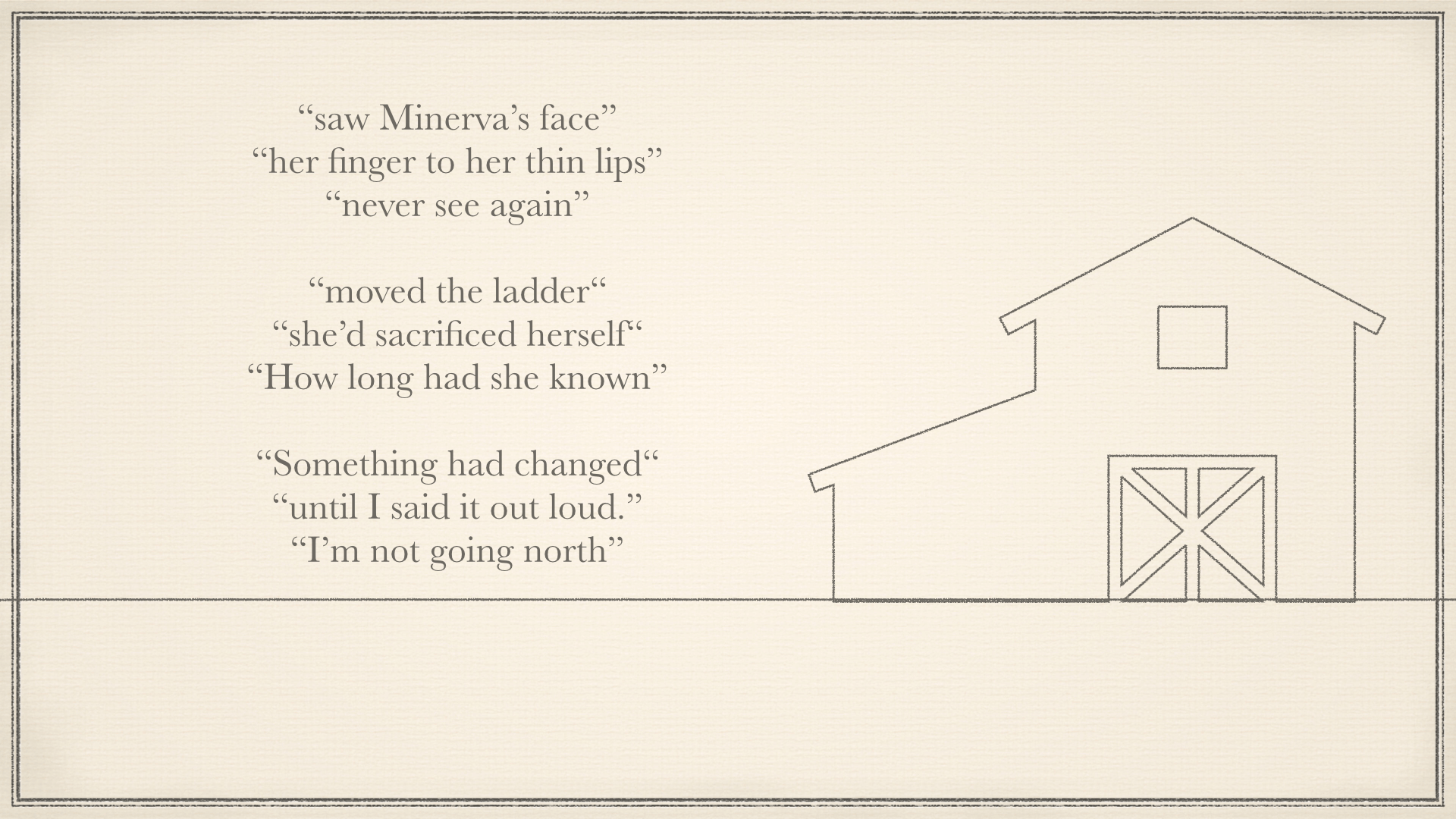







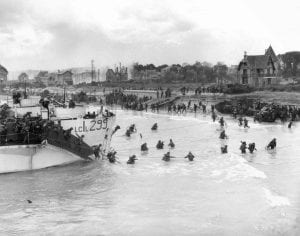 To start we continued our understanding of historical significance that we have been building for the past few years. We defined the word and after a lot of research wrote about the 3 most important reasons why WWII was significant. We had the choice to write about why WWII was significant for us as a nation or why Canada’s impact was significant elsewhere. I chose to talk about why it was important for us as a nation. Through this process I saw a lot of similarities to WWI especially with the job opportunities for women. In both of the wars women joined the work force but in this war women could do jobs that involved a degree. For example I learned That the world’s first female aeronautical engineer was in Canada! She was in charge of producing fighter jets called hurricanes for the war effort. I also learned that social security and unemployment insurance was created during WWII. This assignment showed my deep understanding of the analysis competency which is about accessing the significance of something over time. I never understood how much WWII connects to Canada policies until this project.
To start we continued our understanding of historical significance that we have been building for the past few years. We defined the word and after a lot of research wrote about the 3 most important reasons why WWII was significant. We had the choice to write about why WWII was significant for us as a nation or why Canada’s impact was significant elsewhere. I chose to talk about why it was important for us as a nation. Through this process I saw a lot of similarities to WWI especially with the job opportunities for women. In both of the wars women joined the work force but in this war women could do jobs that involved a degree. For example I learned That the world’s first female aeronautical engineer was in Canada! She was in charge of producing fighter jets called hurricanes for the war effort. I also learned that social security and unemployment insurance was created during WWII. This assignment showed my deep understanding of the analysis competency which is about accessing the significance of something over time. I never understood how much WWII connects to Canada policies until this project.
 My
My This investigation was about building your knowledge that you would need to complete this project and storing it in a PKM. I found this first investigation the most infuriating. Researching, which involved reading articles as a class and watching videos like the “Happiness Advantage”, was very enjoyable. Also, learning about the culture of Disney was very interesting. Walt Disney’s mindset when created these theme parks was so different from other people of his time. What was infuriating? While reading articles and watching the videos we had to MAKE (not to be mistaken for TAKE) notes, which was expected. But then we had to write a summary. The 4 – 2 – 1 structure was challenging.
This investigation was about building your knowledge that you would need to complete this project and storing it in a PKM. I found this first investigation the most infuriating. Researching, which involved reading articles as a class and watching videos like the “Happiness Advantage”, was very enjoyable. Also, learning about the culture of Disney was very interesting. Walt Disney’s mindset when created these theme parks was so different from other people of his time. What was infuriating? While reading articles and watching the videos we had to MAKE (not to be mistaken for TAKE) notes, which was expected. But then we had to write a summary. The 4 – 2 – 1 structure was challenging. Early on we were put into groups and assigned a specific aspect of our driving question. My group focused on how Disney theme parks formed emotional connections for the visitors of the park. For this investigation, as a group we had to come up with a pitch board for a 10 minute documentary. The pitch board had to include the main concept we wanted to get across and the mood we wanted the audience to feel. This part of the project involved a lot of growth in the decision making competency. Working as a group we had to look at our topic from different sides and figure out how to put it all together in the end. A challenge for us? The groups were made up of students from both classes. This made collaborating difficult. We did not understand what the other half of our group had done the class before us. Communication was not clear. Thankfully we used time in our other classes to bring it together but it was still difficult and it was a problem throughout this whole project.
Early on we were put into groups and assigned a specific aspect of our driving question. My group focused on how Disney theme parks formed emotional connections for the visitors of the park. For this investigation, as a group we had to come up with a pitch board for a 10 minute documentary. The pitch board had to include the main concept we wanted to get across and the mood we wanted the audience to feel. This part of the project involved a lot of growth in the decision making competency. Working as a group we had to look at our topic from different sides and figure out how to put it all together in the end. A challenge for us? The groups were made up of students from both classes. This made collaborating difficult. We did not understand what the other half of our group had done the class before us. Communication was not clear. Thankfully we used time in our other classes to bring it together but it was still difficult and it was a problem throughout this whole project. It’s story board time! While working on our pitch board, we came up with a reliant idea. We decided that the main concept we wanted to get across was how the merchandise is a way to take Disney beyond the boundaries of the park.
It’s story board time! While working on our pitch board, we came up with a reliant idea. We decided that the main concept we wanted to get across was how the merchandise is a way to take Disney beyond the boundaries of the park.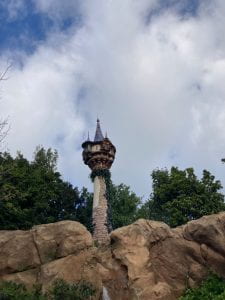

 The main point of this training is to bring about a more optimistic mindset. We wanted to see if we did certain practices or two minutes per day if your outlook would be more positive. Research showed that a more optimistic point of view leads a person to be more productive and more successful. Meditation Mondays was one exercise we tried. I found it very peaceful but with so many people in the room, I could never fully relax or clear my brain.
The main point of this training is to bring about a more optimistic mindset. We wanted to see if we did certain practices or two minutes per day if your outlook would be more positive. Research showed that a more optimistic point of view leads a person to be more productive and more successful. Meditation Mondays was one exercise we tried. I found it very peaceful but with so many people in the room, I could never fully relax or clear my brain.
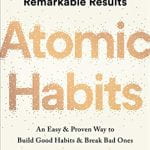 James Clear promises remarkable results with tiny changes in his book The Atomic Habits. The book is filled with amazing stories that really stood out to me. He gives very helpful suggestions on systems that can help us achieve our goals. He also does a good job at showing us why the systems we are using or trying to use are hard to follow through. For example some people want to go to the gym but their system really works against them.
James Clear promises remarkable results with tiny changes in his book The Atomic Habits. The book is filled with amazing stories that really stood out to me. He gives very helpful suggestions on systems that can help us achieve our goals. He also does a good job at showing us why the systems we are using or trying to use are hard to follow through. For example some people want to go to the gym but their system really works against them.
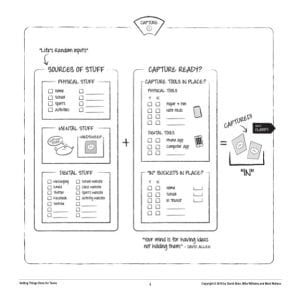

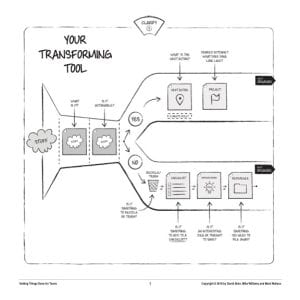
 Actionable
Actionable This step started a week before Disney world and was about planning the trend videos by using storyboarding skills and making prototypes. Starting with storyboarding, I quickly realized that I needed to do more research, because I was planning on doing a Disney food video but I didn’t know where or what food I wanted to use. I am glad I did more research because if you have ever been to Disney World the food and beverages are very imaginative like blue milk!
This step started a week before Disney world and was about planning the trend videos by using storyboarding skills and making prototypes. Starting with storyboarding, I quickly realized that I needed to do more research, because I was planning on doing a Disney food video but I didn’t know where or what food I wanted to use. I am glad I did more research because if you have ever been to Disney World the food and beverages are very imaginative like blue milk!


 Disney was awesome!!! This project was a fun way to express things we experienced at Disney that we want to mention. The video is silly but you still needed to plan it out and think it through in order to make it effective.
Disney was awesome!!! This project was a fun way to express things we experienced at Disney that we want to mention. The video is silly but you still needed to plan it out and think it through in order to make it effective.